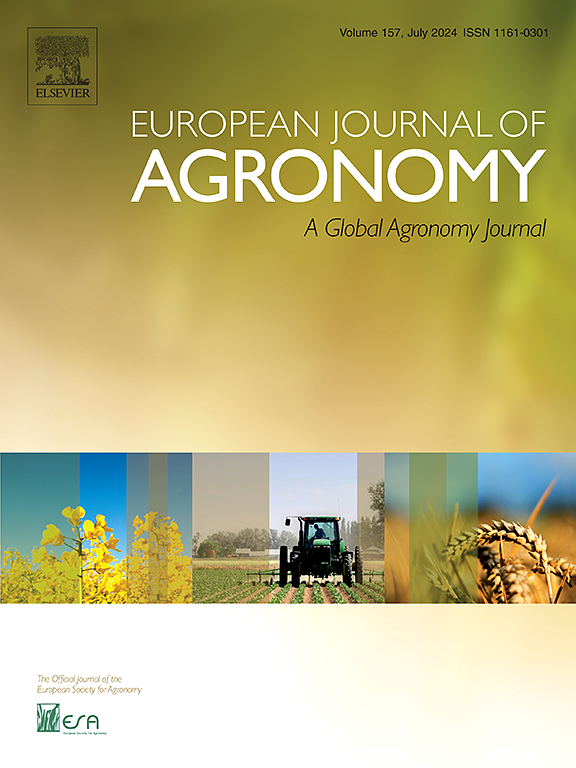氮素配置与再动员优化提高了华北平原冬小麦氮素利用效率
IF 5.5
1区 农林科学
Q1 AGRONOMY
引用次数: 0
摘要
了解灌浆过程中氮素在冠层内的分配和再动员对提高小麦氮素利用效率至关重要。华北平原氮肥管理是如何通过影响氮素在个体器官尺度上的分配和再动员来决定氮素利用效率的,目前尚不清楚。为了解决这个问题,一项为期两年的实地研究量化了不同氮剂量(0-330 kg ha−1)下树冠层间器官特异性氮分配和再调动动态。结果表明,籽粒产量对氮素剂量呈二次响应,在241 kg N ha−1 (8.23 Mg ha−1)时达到峰值,180 ~ 220 kg ha−1的氮素剂量使氮素供应与籽粒氮库发育同步,最大限度地提高了再调动。氮素再动员效率(NRE)与氮素效率参数和籽粒穗长−1呈正相关。器官水平分析表明,不同氮素处理下,冠层上部器官(旗叶、第一节间)的NRE保持稳定(75 ~ 85 %),而冠层下部器官(第3 /4叶/节间)的NRE表现出显著的可塑性(57 ~ 79 %),氮素供应的减少增加了冠层下部器官的NRE。减少氮素供应使花穗氮素分配提高了20.0 %,同时使穗NRE提高了9.7% %。这些动态表明,策略性的氮还原同时保留了上层冠层的光合能力,利用下层冠层的可塑性进行有效的再动员,并优先考虑穗发育作为高效的氮汇。为了协调生产力和可持续性,我们建议利用冠层下部器官的NRE可塑性,通过精确施氮,结合通过育种或生长调节剂增加氮汇,以增加每穗粒数。本文章由计算机程序翻译,如有差异,请以英文原文为准。
Optimization of nitrogen allocation and remobilization improves nitrogen use efficiency of winter wheat in the North China Plain
Understanding the allocation and remobilization of nitrogen within canopy during grain filling is crucial for improving nitrogen use efficiency in wheat. How nitrogen fertilizer management in the North China Plain (NCP) determines nitrogen use efficiency by impacting the allocation and remobilization of nitrogen at the individual organs scales remains unclear. To address this, a two-year field study quantified organ-specific nitrogen allocation and remobilization dynamics across canopy hierarchies under varying nitrogen doses (0–330 kg ha−1). Results demonstrated a quadratic response of grain yield to nitrogen doses, peaking at 241 kg N ha−1 (8.23 Mg ha−1), and nitrogen doses of 180–220 kg ha−1 synchronized nitrogen supply with grain nitrogen-sink development, maximizing remobilization. Nitrogen remobilization efficiency (NRE) was positively associated with nitrogen efficiency parameters and grains spike−1. Organ-level analysis revealed that upper-canopy organs (flag leaf, first internode) maintained stable NRE (75–85 %) across nitrogen regimes, while lower-canopy organs (3rd/4th leaves/internodes) exhibited significant plasticity (NRE: 57–79 %), with reduced nitrogen supply increasing NRE of lower-canopy organs. Reduced nitrogen supply elevated nitrogen allocation to spikes at anthesis by 20.0 %, concurrently enhancing spike NRE by 9.7 %. These dynamics demonstrate that strategic nitrogen reduction simultaneously preserves photosynthetic capacity in the upper canopy, exploits lower-canopy plasticity for efficient remobilization, and prioritizes spike development as a high-efficiency nitrogen sink. To reconcile productivity and sustainability, we propose to exploit NRE plasticity in lower canopy organs through precision nitrogen placement, combined with nitrogen-sink enhancement via either breeding or growth regulators to increase grains per spike.
求助全文
通过发布文献求助,成功后即可免费获取论文全文。
去求助
来源期刊

European Journal of Agronomy
农林科学-农艺学
CiteScore
8.30
自引率
7.70%
发文量
187
审稿时长
4.5 months
期刊介绍:
The European Journal of Agronomy, the official journal of the European Society for Agronomy, publishes original research papers reporting experimental and theoretical contributions to field-based agronomy and crop science. The journal will consider research at the field level for agricultural, horticultural and tree crops, that uses comprehensive and explanatory approaches. The EJA covers the following topics:
crop physiology
crop production and management including irrigation, fertilization and soil management
agroclimatology and modelling
plant-soil relationships
crop quality and post-harvest physiology
farming and cropping systems
agroecosystems and the environment
crop-weed interactions and management
organic farming
horticultural crops
papers from the European Society for Agronomy bi-annual meetings
In determining the suitability of submitted articles for publication, particular scrutiny is placed on the degree of novelty and significance of the research and the extent to which it adds to existing knowledge in agronomy.
 求助内容:
求助内容: 应助结果提醒方式:
应助结果提醒方式:


